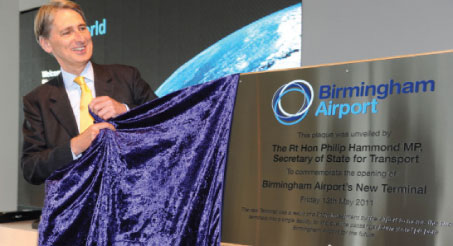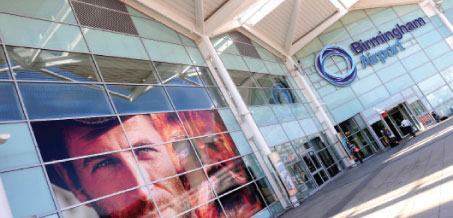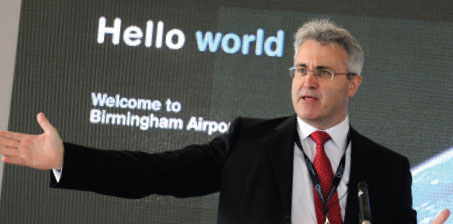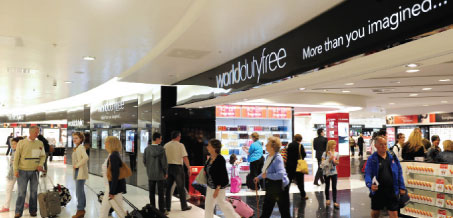
UK Transport Secretary Philip Hammond: “We have always been clear that regional airports have a vital role to play in supporting both local and national economies, and improving connectivity.”
The £13 million (€15m) ‘One Terminal’ development is the latest step in Birmingham Airport’s dynamic strategy for future growth. The airport rebranded last October, dropping the word ‘International’ from its name in a move designed to create positive awareness of its potential and generate loyalty from those living in its catchment area.
There are around eight million people living within an hour’s drive of the airport, but less than 40% of that potential demand uses Birmingham Airport. Kehoe expressed determination to increase that figure over the next few years. “We want people to think about their journey in a new way, and not to be bound by old habits,” he said. “The new terminal frontage comprises the new ‘Hello World’ messages from its new identity and giant faces from different nationalities welcome customers to the site. The new identity signifies global connectivity from Birmingham Airport and its multicultural environment. Our previous brand identity didn’t reflect what we were about and what we aspire to be in the future. We want to embrace the fact that we can connect people to over 400 different places worldwide and want people to feel proud and excited about the opportunities that lie ahead.”
The airport has also recently restructured its Air Services Development department to bring in new airlines, increasing the route network and delivering profitable growth in air traffic at Birmingham. The strategy is to build relationships and knowledge about the airport, in order to demonstrate to the airlines that they have an important role to play in the realisation of Birmingham Airport’s potential.
Speaking at the opening of the new terminal, Transport Secretary Philip Hammond said: “We have always been clear that regional airports have a vital role to play in supporting both local and national economies, and improving connectivity. In addition, Birmingham is well placed to help ease the congestion at airports in the south east, and our proposals for high-speed rail could bring Birmingham Airport to within just 38 minutes of the capital.”

The exterior of the passenger terminal has been given a complete facelift to incorporate the airport’s new identity.
Global gateway
Birmingham Airport handled 8.5 million passengers in 2010 – a decline of -5.8% year-on-year. Factors such as the economic downturn, extreme weather and the volcanic ash cloud were largely responsible for the decrease. Kehoe said: “We always envisaged that 2010 would be a challenging year for the aviation industry, however, I don’t think that anyone could have foreseen the impact of the volcanic ash in April. This event alone cost the airport £2 million (€2.3m) in lost revenue and had a significant impact on consumer confidence.”
The highlight in 2010 was the +17.1% rise in passengers travelling to and from Asia. Emirates’ twice-daily service to Dubai was notably successful. In total, 720,000 passengers flew between Birmingham and destinations such as Islamabad, Dubai, Ashkhabad and Tehran.
Significant growth in passenger numbers is not expected this year. “The market remains fragile and there is still the expectation that 2011 will be another difficult year,” commented Kehoe. “Nevertheless, the investments we are making now will allow us to come out of the economic downturn in a stronger position to take additional traffic and truly become the Midlands’ global gateway.”

Paul Kehoe, CEO, Birmingham Airport: “Most airports under ten million passengers do not need two terminals with two security search areas, two retail and catering offers and split site operations. We therefore embarked on this project to make the operation more efficient, to create a better passenger experience and to offer a facility that is easy to get through.”
Better passenger experience
The new terminal has led to the development of a larger centralised passenger security search area, which enables the airport to process passengers more quickly and in a more pleasant environment. Meanwhile, the enlarged arrivals area provides a Costa Coffee, a new M&S Simply Food, a large WHSmith store, and increased lounge space with views of the airfield.
“Most airports under ten million passengers do not need two terminals with two security search areas, two retail and catering offers and split site operations. We therefore embarked on this project to make the operation more efficient, to create a better passenger experience and to offer a facility that is easy to get through,” explained Kehoe. “Combining the two terminals into one has been a very challenging redevelopment, with many complicated activities taking place in a 24-hour live operation. A great deal of planning, partnerships and hard work by everyone involved has produced this first-class facility, on programme, on time, and with minimal passenger disruption.”

The new 20,000sq ft walkthrough World Duty Free store located airside is 50% larger than the previous offer and features a wider range of products across all categories.
The redevelopment includes significant expansion of the retail offer. The new 20,000sq ft walkthrough World Duty Free store located airside is 50% larger than the previous offer and features a wider range of products across all categories, including liquor, beauty, accessories and confectionery. Distinct ’boutique’ areas and bays are occupied by various brands.
The fashion offer will be further improved in July, with the opening of Next, JD Sports and Superdry stores, creating 50 new jobs. “We are also delighted with the success of ‘Blanc et Noir’ – a specialist offer with a range of champagnes and some of the finest wines of the world. It also offers quality coffees, continental, mezze and cheese platters, and open sandwiches,” commented Kehoe.
In addition to the internal changes, the exterior of the passenger terminal has been given a complete facelift to incorporate the airport’s new identity.
Other projects being undertaken as part of the £100 million (€115m) redevelopment include a new International Pier, a 3,365-space multi-storey car park, taxiway improvements, a new ATC tower (to open in 2013) and a runway extension scheme (to be operational in 2014). “Our runway extension will allow for direct flights to China, South East Asia, the west coast of America and South Africa, and will also go a long way to clawing back the market which currently ventures outside of the region for air travel,” said Kehoe.
Birmingham Airport is increasingly being acknowledged as a strategic national asset for the UK, with a crucial role to play as part of an integrated transport system. The investment in the airport places it in a strong position to meet anticipated growth in demand for air travel. It also showcases the airport as the region’s global gateway.







